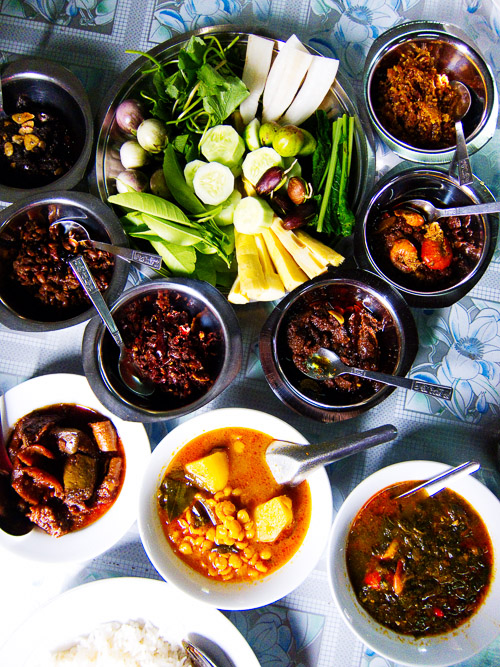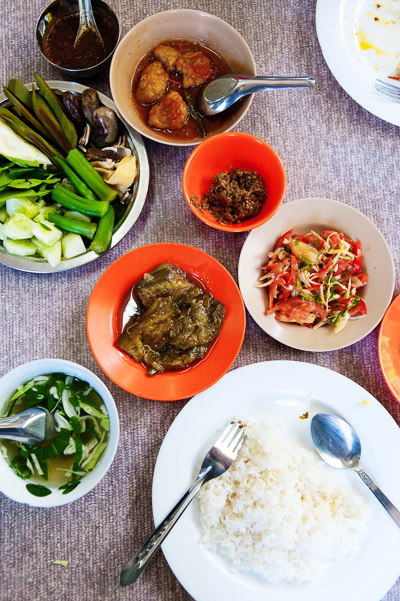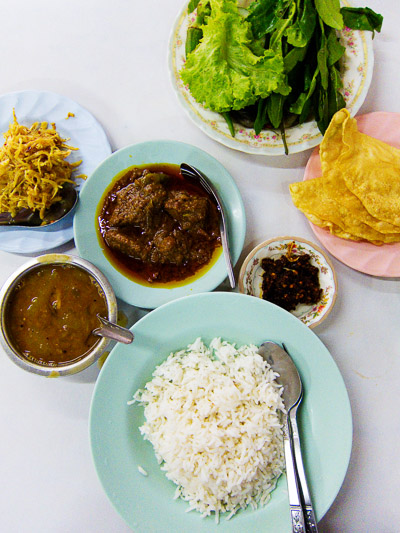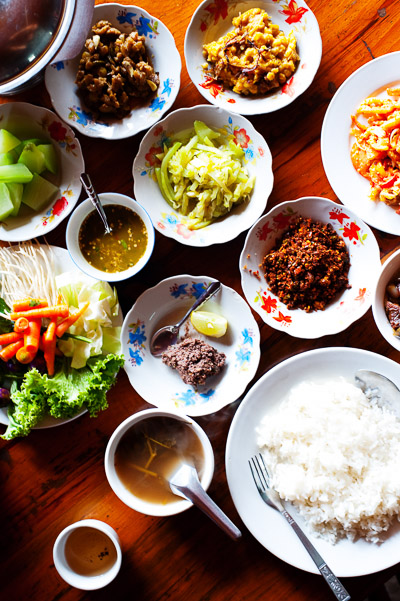 Relatively little is known about Burmese food outside of the country. And even those who visit Myanmar tend to come away from the country with a generally negative impression of its eats, as summarised in this excerpt from the most recent version of Lonely Planet's Myanmar (Burma) guidebook:
Relatively little is known about Burmese food outside of the country. And even those who visit Myanmar tend to come away from the country with a generally negative impression of its eats, as summarised in this excerpt from the most recent version of Lonely Planet's Myanmar (Burma) guidebook:
Burmese food has a reputation for being oily. We won’t deny this, but in its defence will posit that much of this is the fault of the curries.
The centrepiece of any Burmese meal, hin, Burmese-style curries, are generally cooked until the oil separates from all other ingredients and rises to the top. The Burmese term for this cooking method is s’i pyan, ‘oil returns’, and the process ensures that the rather harsh curry paste ingredients -- typically turmeric, tomatoes, ginger, garlic, onions, and shrimp paste -- have properly amalgamated and have become milder. Some restaurants also add extra oil to maintain the correct top layer, as the fat also preserves the underlying food from contamination by insects and airborne bacteria while the curries sit in open, unheated pots for hours at a time.
The good news is that all this oil isn’t necessarily meant to be eaten and it’s usually easy enough to work around it. Those who got burned by the spiciness of Thai food will be pleased to learn that Burmese curries are the mildest in Asia in terms of chilli power -- in fact most cooks don't use chillies at all in their recipes. It’s also worth mentioning that the most common curry proteins you’ll encounter are fish, chicken, prawns or mutton. Relatively little beef or pork is eaten by people in Myanmar -- beef because it's considered offensive to most Hindus and Burmese Buddhists, and pork because the nat (spirits) disapprove.
Most importantly, it’s crucial to keep in mind that a curry only constitutes a single element of a Burmese meal. The requisite side dishes, which include various soups, salads, dips and fresh herbs, often have little or no oil.
So yes, when eating in Myanmar, you're going to encounter a bit of oil. But the sheer diversity of dishes that make up a traditional Burmese meal acts as something of a counterpoint to this. Upon arriving at any Myanma saa thauk sain ('Burmese Eat Drink Shop' -- a Burmese curry restaurant), after you’ve chosen a curry, fried dish or salad, a succession of side dishes will follow. These include soup -- either an Indian-influenced peh-hin-ye (lentil soup, or dhal) or a tart leaf-based hin-jo (sour soup) -- as well as a tray of fresh and par-boiled vegetables and herbs, to be eaten with various dips ranging from ngapi ye, a watery, fishy dip, or balachaung, a dry, pungent combination of chillies, garlic and dried shrimp fried in oil. By the time it all arrives, you'll be faced with a huge -- practically overwhelming -- spread of dishes that runs the gamut of ingredients, textures and flavours.
I can't imagine a better introduction to this type of eating than Aung Thuka:
Located near the Shwedagon Pagoda, Aung Thukha is a Yangon restaurant legend that excels at herbal, relatively light Burmese dishes. This emphasis on herbs is evident in the house soup (pictured above at 8 o'clock), which is clear and delicate, and is flavoured with little more than slightly pungent local leaves. The fried dishes and curries have the requisite oil, but are also relatively light and fragrant; I particularly love their rich, tomatoey fish cake curry (pictured at 12 o'clock, above). Aung Thukha also do some very good salads -- all made to order -- including a tart and refreshing tomato salad (pictured at 3 o'clock). And after you've finished the savouries, you'll receive the traditional Burmese dessert of a lacquer tray of pickled tea leaves, ginger and nuts, and crunchy chunks of palm sugar.
Aung Thukha Dhamma Zedi Rd, Yangon Lunch & dinner
View Thai Eats in a larger map
An analogue to this is central Yangon's Shwe Mei Tha Su, the Muslim version of the Burmese curry restaurant:
Instead of the clear, herb-based side soup, here you'll get a bowl of slightly watery lentils studded with root vegetables. There was a salty/spicy balachaung and a side of crispy papadums. They do a great shauq-thi dhouq, a salad made from an indigenous, lemon-like fruit (pictured at 10 o'clock). And a Muslim-style curry shop is one of relatively few places in Myanmar where you'll find beef (in the centre of the pic above), and the beef curry here is fragrant and sweet -- practically bordering on candied -- a stark contrast with predominately salty/savoury 'Buddhist' Burmese dishes.
Shwe Mei Tha Su 173 29th St, Yangon Lunch & dinner
View Thai Eats in a larger map
Upcountry, Burmese-style curry restaurants that exemplified this type of dining include San Ma Tau, another old-school, hall-like restaurant in Hpa-an, Kayin State. This place had the biggest range of balachaung I encountered just about anywhere in Myanmar (pictured at the top of this post), and lots of interesting fresh herbs and vegetables to accompany them. They also served a great number of really delicious veggie-based sides, from a dish of slow-cooked, nearly melted eggplant to a small side of flash-fried okra.
San Ma Tau Myanmar Restaurant 1/290 Bokyoke St (Hwy 85), Hpa-an Lunch & dinner
View Thai Eats in a larger map
There's not a lot of good food in Nyaungshwe, the jumping-off point for Inle Lake, which makes Lin Htett all the more interesting:
This is another place that takes its vegetables seriously -- many of them grown on Inle Lake's famous floating gardens. They do some excellent salads here, including a refreshingly herbal pennywort salad and a tart tomato salad (pictured at 2 o'clock). And not surprisingly, freshwater fish features on the menu, and they do a great, rich Burmese-style fish curry.
Lin Htett Myanmar Traditional Food Yone Gyi Rd, Nyaungshwe Lunch & dinner
View Thai Eats in a larger map














